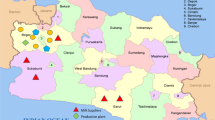Abstract
A mixed integer linear programming model to support strategic decision making is presented, in order to find the optimal processing structure for a slaughter byproduct business. In an integrated approach environmental objectives (such as odour emission, water pollution and energy consumption), market outlets, quality requirements (both for product and process), costs of processing, transportation, environmental measures and governmental restrictions are modelled to find the optimal investment strategy for future ways of processing slaughter by-products. Emphasis has not been put on development of new models or techniques. The value of this contribution is how to find new cost-effective logistical solutions within a framework of environmental restrictions, quality and technological opportunities.
Zusammenfassung
In diesem Beitrag wird ein gemischt ganzzahlig lineares Optimierungsmodell vorgestellt, um eine bestmögliche Verarbeitung und Vermarktung von Nebenprodukten der Schlachtung zu ermöglichen. In einem integrierten Modell werden umweltpolitische Aspekte (wie Geruchsemission, Wasserverunreinigung und Energieverbrauch), Absatzmöglichkeiten, Qualitätsaspekte (dies gilt sowohl für die Endprodukte als auch für den Herstellungsprozeß), Kosten, Infrastruktur, umweltpolitische Auflagen und gesetzliche Vorschriften berücksichtigt, um optimale zukunftstragende Investitionen für die Verarbeitung von Nebenprodukten der Schlachtung zu finden. Der Schwerpunkt lag dabei nicht in der Entwicklung von neuen Modellen oder Methoden, sondern im Erkennen von neuen kostengünstigen logistischen Lösungen in einem Zusammenspiel von Umweltauflagen, Qualität und technologischen Chancen.
Similar content being viewed by others
References
Anonymous (1994) Verhinderung der Zersetzung von Rohmaterial durch Kühlung. Technisches Komitee der Eura gibt Hinweise. Die Fleischmehlindustrie 46:192–200
Baas CM, Geudens PJJG (1994) Nieuwe normen belemmeren afzet zuiveringsslib naar landbouw. Voedingsmiddelentechnologie 24:24–27 (in Dutch)
Bloemhof-Ruwaard JM, Beek P van, Hordijk L, Wassenhove LN van (1995) Interactions between operational research and environmental management. Eur J Oper Res 85:229–243
Boustead I, Hancock GF (1979) Handbook of Industrial Energy Analysis. Ellis Horwood, Chichester, UK
Dijk R van, Logtenberg H (1993) Haalbaarheidsstudie voorbehandeling slachtafvallen ter vermindering van geuroverlast. TNO, no. B 93.003, Zeist, Netherlands (in Dutch)
Doorn W van, Smit I, Vossen F (1994) Bedrijfstakstudie Geur Vleesindustrie, Handleiding voor het vaststellen van de geuremissie en geurimmissie. Project Research Amsterdam BV (in Dutch)
EC-Council (1990) Council directive of 27 November 1990, 90/667/EEC. Off J Eur Commun L363:51
El Boushy ARY, Poel AFB van der (1994) Poultry Feed from Waste, processing and use. Chapman & Hall
Ensminger ME, Olentine CG (1978) Feeds & Nutrition. Ensminger Publishing Company, California
EURA, Technisches Komitee der Eura (1994) Verhinderung der Zersetzung von Rohmaterial durch Kühlung. Fleischmehl-Industrie 46 (10):192–199
Fernandez T (1991) Blood meal, meat and bone meal and tallow, in: Advances in Meat Research 8: Overview of inedible meat. Elsevier Applied Science, New York
Fransen NG (1995) Fermentation of slaughterhouse sludge for feed application. Thesis Utrecht University
Hansen PIE (1994) Some environmental aspects of meat and by-products processing, Evaluation and use of slaughter by products. 40th International conference of meat science and technology. The Hague, Netherlands
Hendriks ThHB (1994) Wageningen Agricultural University, Personal communication
IFIAS (1974) Energy Analysis. Report of: Energy Analysis Workshop on Methodology and Conventions
Lambert AJD, Wolters WTM, Claus J (1993) Quantitative Modelling of Production Chains with respect to Environmental Effects, in Pilivachi P.A. edt., Energy Efficiency in Process Technology, proc. of Int. Conf. on Energy Efficiency in Process Technology. Athens, Elsevier Applied Science
Oberthür RC (1991) Untersuchungsbericht über die Temperaturabhängigkeit der bakteriellen Zersetzung von Schlachtblut. Fleischmehl-Industrie 43(7):122–130
Swan JE (1988) Production, prices and trends for New Zealand meat and bone meal and tallow. Meat Industry Research Institute of New Zealand
Urlings HAP (ed.) (1995) Upgrading of slaughter by-products for animal nutrition; innovative technologies, hygiene, environmental care, quality assurance. Dept. of the Science of Food of Animal Origin, Utrecht University
Urlings HAP (1992) Fermentation of animal by-products. Thesis Utrecht University
Veerkamp CH (1994) Model to determine Energy Consumption (to heat, to chill, to dry). ID-DLO, Beekbergen, Netherlands
Verheijen LAHM, Wiersema D, Hulshoff Pol LW, Wit J de (1996) Livestock and the environment, finding a balance. Management of waste from animal product processing. International Agricultural Centre Wageningen, The Netherlands
Author information
Authors and Affiliations
Rights and permissions
About this article
Cite this article
van Sonsbeek, J.T.M., van Beek, P., Urlings, H.A.P. et al. Mixed integer programming for strategic decision support in the slaughter by-product chain. OR Spektrum 19, 159–168 (1997). https://doi.org/10.1007/BF01545519
Received:
Accepted:
Issue Date:
DOI: https://doi.org/10.1007/BF01545519




